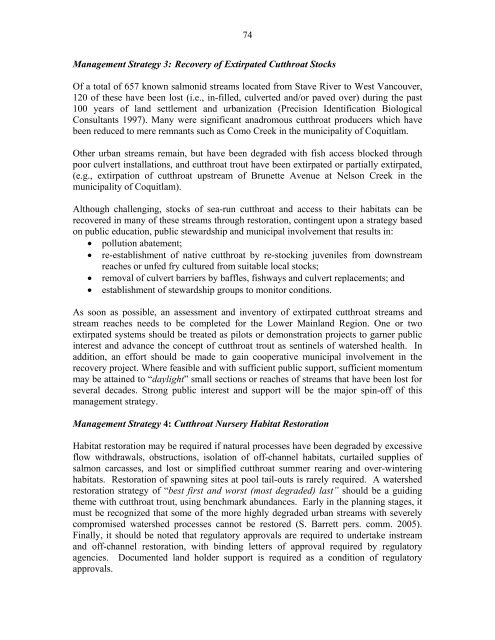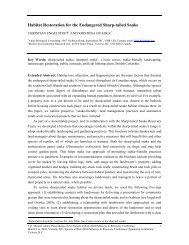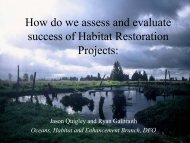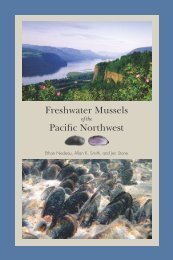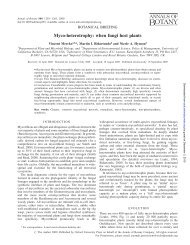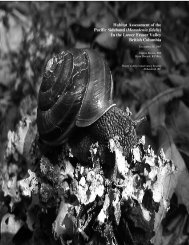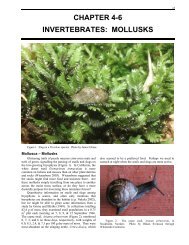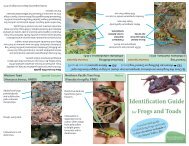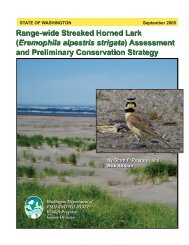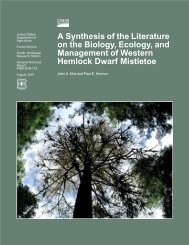Coastal Cutthroat Trout as Sentinels of Lower Mainland Watershed ...
Coastal Cutthroat Trout as Sentinels of Lower Mainland Watershed ...
Coastal Cutthroat Trout as Sentinels of Lower Mainland Watershed ...
You also want an ePaper? Increase the reach of your titles
YUMPU automatically turns print PDFs into web optimized ePapers that Google loves.
74Management Strategy 3: Recovery <strong>of</strong> Extirpated <strong>Cutthroat</strong> StocksOf a total <strong>of</strong> 657 known salmonid streams located from Stave River to West Vancouver,120 <strong>of</strong> these have been lost (i.e., in-filled, culverted and/or paved over) during the p<strong>as</strong>t100 years <strong>of</strong> land settlement and urbanization (Precision Identification BiologicalConsultants 1997). Many were significant anadromous cutthroat producers which havebeen reduced to mere remnants such <strong>as</strong> Como Creek in the municipality <strong>of</strong> Coquitlam.Other urban streams remain, but have been degraded with fish access blocked throughpoor culvert installations, and cutthroat trout have been extirpated or partially extirpated,(e.g., extirpation <strong>of</strong> cutthroat upstream <strong>of</strong> Brunette Avenue at Nelson Creek in themunicipality <strong>of</strong> Coquitlam).Although challenging, stocks <strong>of</strong> sea-run cutthroat and access to their habitats can berecovered in many <strong>of</strong> these streams through restoration, contingent upon a strategy b<strong>as</strong>edon public education, public stewardship and municipal involvement that results in:• pollution abatement;• re-establishment <strong>of</strong> native cutthroat by re-stocking juveniles from downstreamreaches or unfed fry cultured from suitable local stocks;• removal <strong>of</strong> culvert barriers by baffles, fishways and culvert replacements; and• establishment <strong>of</strong> stewardship groups to monitor conditions.As soon <strong>as</strong> possible, an <strong>as</strong>sessment and inventory <strong>of</strong> extirpated cutthroat streams andstream reaches needs to be completed for the <strong>Lower</strong> <strong>Mainland</strong> Region. One or twoextirpated systems should be treated <strong>as</strong> pilots or demonstration projects to garner publicinterest and advance the concept <strong>of</strong> cutthroat trout <strong>as</strong> sentinels <strong>of</strong> watershed health. Inaddition, an effort should be made to gain cooperative municipal involvement in therecovery project. Where fe<strong>as</strong>ible and with sufficient public support, sufficient momentummay be attained to “daylight” small sections or reaches <strong>of</strong> streams that have been lost forseveral decades. Strong public interest and support will be the major spin-<strong>of</strong>f <strong>of</strong> thismanagement strategy.Management Strategy 4: <strong>Cutthroat</strong> Nursery Habitat RestorationHabitat restoration may be required if natural processes have been degraded by excessiveflow withdrawals, obstructions, isolation <strong>of</strong> <strong>of</strong>f-channel habitats, curtailed supplies <strong>of</strong>salmon carc<strong>as</strong>ses, and lost or simplified cutthroat summer rearing and over-winteringhabitats. Restoration <strong>of</strong> spawning sites at pool tail-outs is rarely required. A watershedrestoration strategy <strong>of</strong> “best first and worst (most degraded) l<strong>as</strong>t” should be a guidingtheme with cutthroat trout, using benchmark abundances. Early in the planning stages, itmust be recognized that some <strong>of</strong> the more highly degraded urban streams with severelycompromised watershed processes cannot be restored (S. Barrett pers. comm. 2005).Finally, it should be noted that regulatory approvals are required to undertake instreamand <strong>of</strong>f-channel restoration, with binding letters <strong>of</strong> approval required by regulatoryagencies. Documented land holder support is required <strong>as</strong> a condition <strong>of</strong> regulatoryapprovals.


